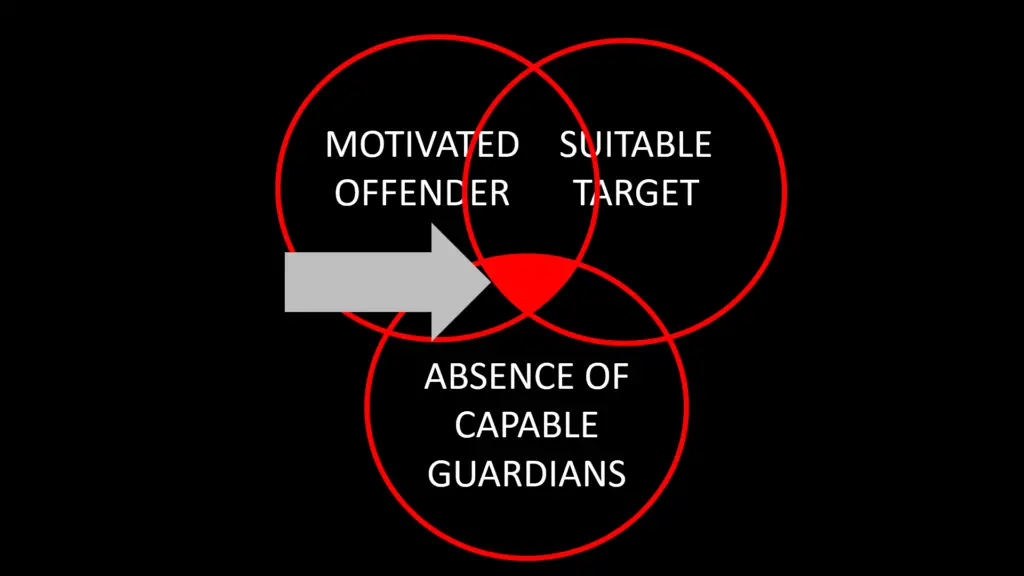Routine activities theory is a theory that tries to explain why crime happens. It is very well-known in the fields of criminology and sociology and was originally developed by Lawrence Cohen and Marcus Felson. In 1979, they published a now famous article where they proposed the central idea of the theory.
Table of Contents
Routine Activities Theory: Definition and Meaning
So what does routine activities theory say? Routine activities theory is based on the idea that offenders make rational choices about whether to commit a crime. The idea is that crime is the result of people’s everyday behavior, of the way in which offenders and victims go about their daily lives. Crime is not something extraordinary that requires a deep psychological analysis. Instead, the theory says that for crime to occur, three elements must be present, namely (1) a motivated offender, (2) a suitable target, and (3) the absence of capable guardians. When these three elements come together at the same time in the same space, crime occurs.

The Elements of the Routine Activity Approach
So let’s have a look at each of these three elements. The first is a motivated offender. Although this is one of the three central elements, routine activities theory is not very interested in it. Cohen and Felson simply assume that a motivated offender is present. They’re not interested in why the offender is motivated. This is where the theory is different from most criminological theories, which are focused on why the offender wants to commit a crime. Instead, routine activities theory is more interested in the victimization side, which is why it’s very influential in victimology. So, routine activities theory doesn’t suggest that it takes deep, psychological motivations to commit a crime; instead, ordinary people can be convinced to commit crime relatively easily. Whether people decide to commit crime depends on the other two elements, namely whether a suitable target and guardianship are present.

Cohen and Felson’s Suitable Target
The second element is that a suitable target needs to be present. The question here is what makes a target suitable? A number of factors play a role:
- First, there is the value of a target. This can refer to money, like how much something is worth financially, or also, for example, to what it means for someone’s status, like, for example, having a particular gadget.
- Second, there is “inertia”, which refers to how difficult it is to move or transport an object. For example, it is quite difficult to move very large appliances, like a freezer, whereas it’s much easier to transport a mobile phone.
- Third, how suitable a target is depends on the visibility of the target. If, for example, valuables are left out in plain sight, it’s much easier to steal them than when they’re hidden.
- And finally, the access to a target is an important factor. People and objects that are in a public space that everyone can enter are easier to target compared to a private space.
At first sight, these factors are most applicable to property crime and robbery. In fact, routine activities theory was originally developed to explain direct contact predatory crimes, meaning crimes where an offender comes into direct physical contact with a victim. But it has since been applied to many more types of crimes, for example, drug dealing, cybercrime, and white-collar crime. Target suitability does not just refer to property, but also to crimes against people, because it can also refer to the vulnerability of people to becoming a victim. For example, some victims are less able to defend themselves. Or some victims look like they might carry more valuable items and might therefore be more suitable targets.

The Capable Guardian in Routine Activities Theory
The third element that is necessary for crime to occur is an absence of capable guardianship. Guardianship can be interpreted in many different ways. Of course, one could think of the police because they can prevent crime, but guardianship is meant in a much broader way. In fact, it’s often the presence of ordinary people that can prevent crime. For example, if an offender is motivated to commit crime, he or she might not do it if there are many people around. These people act as guardians simply by being present, because they might act when they see a crime happening. On the other hand, of course, if guardians are absent, a crime is more likely to occur.

So, on the whole, routine activities theory says that crime occurs when these three elements are present. In that sense, crime is not something extraordinary, but the product of everyday life. It occurs when people’s daily routines, like the way they go to school or work, produces opportunities for crime like when a motivated offender comes across a situation where there is an object or a victim that is not well-protected.

Routine Activities Theory and Crime Rates
Cohen and Felson originally developed routine activities theory to explain why crime rates in many western countries increased instead of decreased between the 1950s and the 1970s. Many older criminological theories had said that crime is related to poverty: If poverty goes down, then crime goes down. But the mystery was that between the 1950s and the 1970s poverty went down, yet crime went up. How could that be explained?
What Cohen and Felson said was that the reason that crime went up was not so much due to the motivation of the offenders. Instead, they argued that two factors caused the crime increase. First, people were home less often. More and more women started to work outside of the home which meant that in everyday life, fewer people were present in residential areas. Also, there were more single person households, and people started going out more, like on holiday. That meant that, overall, fewer people were home and guardianship in the neighborhood went down. In other words, it became easier to commit crime, because nobody was watching: there was low guardianship.

On top of that, during the same period, there were more and more suitable targets. People started buying televisions and stereos, for example, that were expensive and could easily be stolen and re-sold. So summing up, it became easier to commit crime, because there were fewer people watching (fewer guardians) and, simultaneously, there was more to steal, namely more suitable targets.

Contribution of Routine Activities Theory to Criminology
Summing up, routine activities theory has a different focus from traditional criminological theories. Whereas those are focused on why offenders are motivated for crime, routine activities theory is more focused on the other two elements, namely on the presence of suitable targets and guardianship. That doesn’t mean that it is necessarily incompatible with traditional theories, but its focus is different which has made it an important part of criminological theory.
References
Cohen, L. E., & Felson, M. (1979). Social change and crime rate trends: A routine activity approach. American Sociological Review, 44 (4):588-608.
